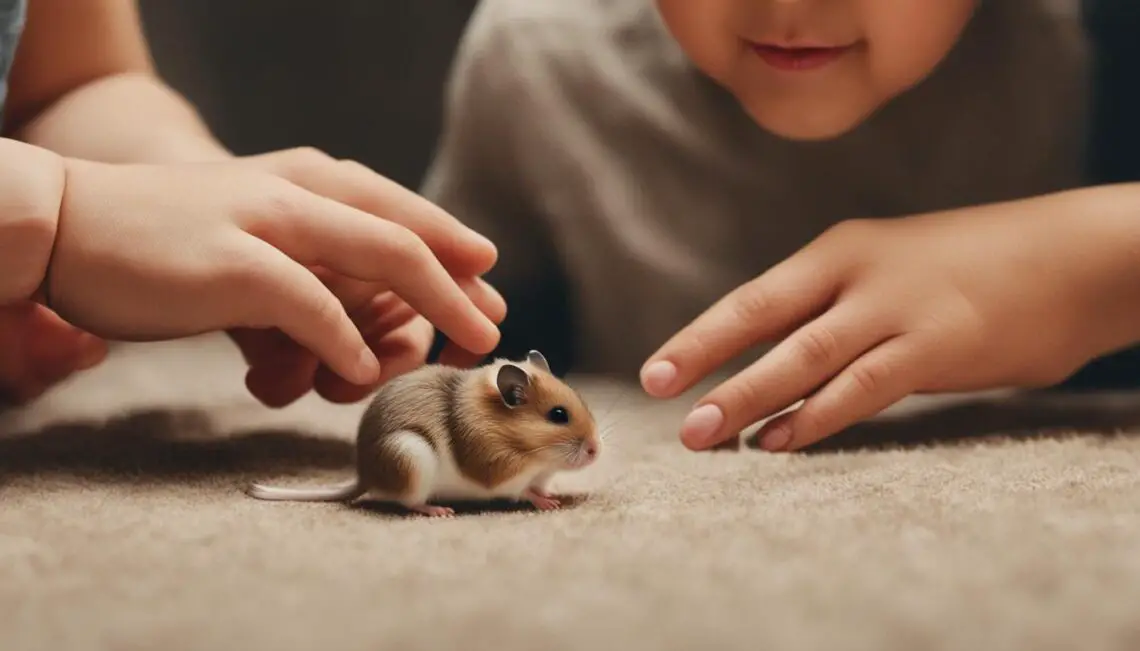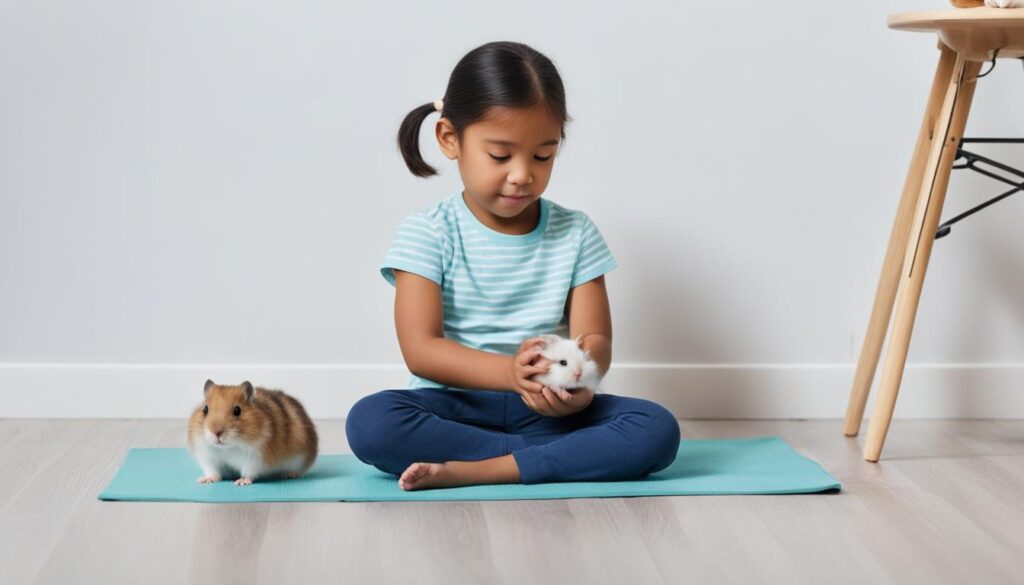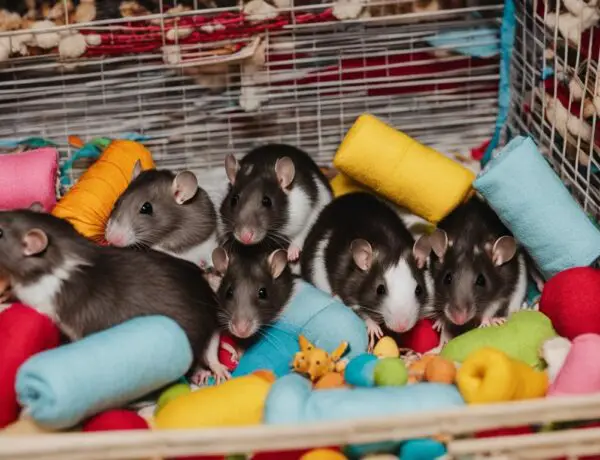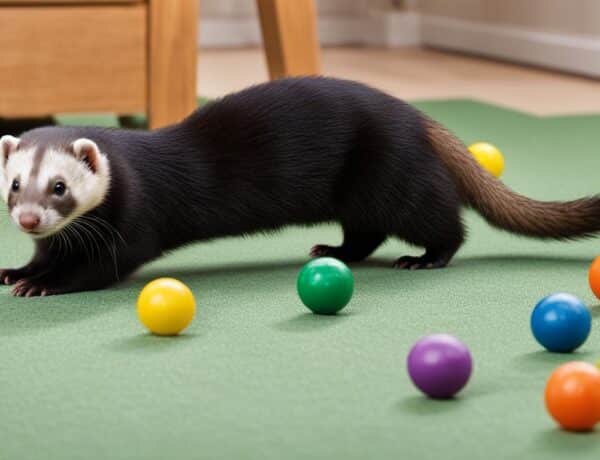When it comes to training small pets to interact with children safely, there are important guidelines to follow. Animals should always be supervised when in a room with children and should never be left alone. Proper hygiene practices, such as handwashing after touching pets, are essential to prevent the spread of germs. It’s also crucial to teach children how to approach and interact with animals, and to set rules for safe interactions. Additionally, knowing what to do in the event of a pet bite is important for preventing further injury.
Key Takeaways:
- Supervise all interactions between small pets and children
- Practice proper hygiene, including handwashing after touching pets
- Teach children how to approach and interact with animals
- Set rules for safe interactions between children and pets
- Know what to do in the event of a pet bite
Hygiene Practices and Safe Interactions
When it comes to interactions between children and small pets, proper hygiene practices are essential to ensure the safety and well-being of both. Children, especially those under five years old, are more susceptible to illnesses caused by bacteria, parasites, and viruses that animals may carry. To minimize the risk of infection, it is recommended that children avoid direct contact with certain animals, including reptiles, amphibians, backyard poultry, and rodents, as they may carry potentially harmful bacteria.
One of the most important hygiene practices is handwashing. It is crucial for children to wash their hands thoroughly with soap and water after playing with pets or visiting places where animals are present. This helps remove any potential germs that may have been transferred from the animals to their hands. Additionally, teaching children to avoid activities such as kissing, snuggling, or holding animals close to their faces can further prevent the spread of germs.
Preventing the spread of germs:
- Wash hands with soap and water for at least 20 seconds after playing with pets.
- Avoid direct contact with reptiles, amphibians, backyard poultry, and rodents.
- Avoid kissing, snuggling, or holding animals close to the face.
Proper hygiene practices, such as regular handwashing and avoiding direct contact with certain animals, are crucial for maintaining safe interactions between children and small pets.
Recommended Hygiene Practices for Interactions with Small Pets
| Hygiene Practice | Description |
|---|---|
| Handwashing | Thoroughly wash hands with soap and water for at least 20 seconds. |
| Avoiding Direct Contact | Avoid direct contact with reptiles, amphibians, backyard poultry, and rodents. |
| Avoiding Face-to-Face Interaction | Avoid activities such as kissing, snuggling, or holding animals close to the face. |
By following these proper hygiene practices, parents can ensure their children’s safe interactions with small pets and minimize the risk of illness or infection.
Safe Interactions Between Pets and Children
Ensuring safe interactions between pets and children is crucial for a harmonious home life. Properly preparing pets for the arrival of a new baby can help minimize anxiety and unwanted behaviors. This can involve working on obedience skills, introducing them to new experiences, and anticipating schedule changes.
It is important to always supervise interactions between pets and babies or young children. Teaching children how to approach and interact with animals, as well as setting rules, can help prevent accidents or injuries. It’s also important to discourage interactions between pets and infants, such as sleeping together, due to the risk of suffocation.
Preparing Pets for a New Baby
When expecting a new baby, it’s essential to prepare pets for the changes that lie ahead. Here are some tips to ensure a smooth transition:
- Gradually introduce your pet to baby-related sounds and smells. Play recordings of babies crying or use baby powder to familiarize them.
- Set up the nursery in advance so your pet can get used to the new environment. Gradually allow them access to the room and reinforce positive behaviors.
- Establish new routines and schedules to prepare your pet for the upcoming changes. This will help them adjust to a different lifestyle.
- Consider a refresher course in obedience training to reinforce good manners and ensure your pet responds well to commands.
By following these steps, you can help your pets adapt to the arrival of a new baby and create a safe and harmonious environment for everyone.
“A harmonious home life is achievable when pets and children interact safely, and careful preparation is key to success.”
Preventing Bites and Understanding Pet Behavior
When it comes to preventing pet bites, education and understanding pet behavior are key. Dogs and cats may resort to biting or scratching if they feel threatened or scared. It’s important for both adults and children to be aware of these behaviors and learn how to read a pet’s body language.
Teaching children to be gentle and respectful towards animals is crucial for preventing bites. Encourage them to ask for permission before approaching a pet and to respect the pet’s space. By understanding and respecting a pet’s boundaries, the risk of bites can be significantly reduced.
Reading Pet Body Language
Recognizing the signs of aggression and fear in pets can help prevent potential bites. Here are some common behaviors to watch out for:
- Growling or baring teeth
- Stiff body posture
- Intense staring or wide eyes
- Flattened ears or hair standing on end
- Tail wagging or positioning
By paying attention to these signals, you can assess a pet’s state of mind and take appropriate action to prevent bites.
“Understanding pet behavior and being able to read their body language is essential for preventing bites.”
In the event of a pet bite, it’s important to take immediate action. Clean the wound with soap and water, apply an antiseptic, and cover it with a clean bandage. If the bite appears serious or becomes infected, seek medical attention promptly.
Here’s an informative table that provides an overview of common pet behaviors and their corresponding meanings:
| Behavior | Meaning |
|---|---|
| Growling or baring teeth | Sign of aggression or perceived threat |
| Stiff body posture | Indication of fear or discomfort |
| Intense staring or wide eyes | Expression of dominance or potential aggression |
| Flattened ears or hair standing on end | Sign of fear or aggression |
| Tail wagging or positioning | Can indicate different emotions depending on the context |
By understanding pet behavior and taking appropriate measures to prevent bites, you can create a safe environment for both pets and children.
Conclusion
Training small pets to interact with children safely is crucial for fostering optimal pet-child interactions and ensuring a harmonious home life. By following proper hygiene practices, preparing pets for new arrivals, and understanding pet behavior, we can create a safe environment where children and pets can thrive together.
Supervision is key when it comes to interactions between children and pets. Always make sure that a responsible adult is present to oversee interactions, particularly with young children. This helps prevent accidents and ensures that both children and pets feel safe and secure.
In addition to supervision, teaching children to respect animals is essential. Educate them on the importance of gentle touch, asking for permission before approaching a pet, and respecting a pet’s personal space. By instilling these values, children can develop empathy, responsibility, and a lifelong appreciation for the well-being of animals.
Lastly, it’s important to be prepared for the unexpected. Knowing what to do in the event of a pet bite is crucial for minimizing further injury and preventing infections. Clean the wound thoroughly, seek medical attention if necessary, and be vigilant for any signs of infection or complications.
By taking these precautions and implementing safe practices, we can create an environment that promotes optimal pet-child interactions and allows both children and pets to flourish. Through these interactions, children can develop valuable skills, such as empathy and responsibility, while building lifelong bonds with their beloved furry friends.
FAQ
What are some important guidelines for training small pets to interact with children safely?
Small pets should always be supervised when in a room with children and should never be left alone. It’s also crucial to teach children how to approach and interact with animals, and to set rules for safe interactions.
Why are good hygiene practices important in interactions between children and small pets?
Good hygiene practices are important because children, especially those under five years old, are more vulnerable to illnesses caused by bacteria, parasites, and viruses that animals may carry. Handwashing after playing with pets or visiting places where animals are present is essential.
How can interactions between pets and children be made safe in a home environment?
Interactions between pets and children can be made safe by properly preparing pets for the arrival of a new baby, supervising interactions, teaching children how to approach and interact with animals, and setting rules to prevent accidents or injuries.
How can pet bites be prevented and what should be done if a pet bite occurs?
Pet bites can be prevented by teaching children to be gentle, to ask for permission before approaching an animal, and to respect a pet’s space. In the event of a pet bite, it is important to clean the wound, seek medical attention if necessary, and watch for signs of infection.







No Comments